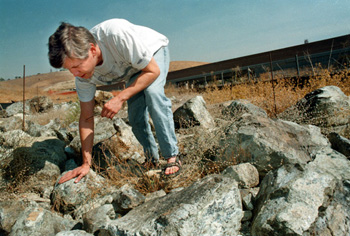![[Metroactive News&Issues]](/gifs/news468.gif)
[ San Jose | Metroactive Central | Archives ]
 Photograph by George Sakkestad Life on the Edge: Craig Breon, an activist with the Santa Clara Valley Audubon Society, examines an outcropping of serpentine rocks, which create soil conditions that aid in the survival of such endangered species as the bay checkerspot butterfly. Unnatural Selection The valley of developers' delight takes a daily toll on dying species By Jim Rendon AS A SPECIES, humans have a habit of wreaking havoc on the environment. Indigenous societies invented environmentally devastating slash-and-burn agriculture. Some Middle Eastern cultures turned their rich agricultural land into desert through overirrigation. But those previous cultures had a safety net. There were not enough of them to cause significant large-scale damage. Their technology was limited. They lived close enough to the land to know when things were really getting screwed up. We're not quite as lucky. If anything, our penchant for squashing everything around us has increased exponentially. Our technology, not to mention heavy equipment and our booming population of 6 billion, has helped humans really get into trouble. Right now, many biologists warn, the earth is in the midst of the most rapid extinction of species ever recorded. Two hundred years after Europeans first showed their faces here, the Santa Clara Valley has been completely transformed. Early Spanish explorer Juan Crespi's description of the Guadalupe River is almost impossible to reconcile with the channeled urban waterway that parallels the Guadalupe Parkway today. In his journal, the explorer wrote, "At the end of the estuary they had come upon a full flowing river, having a great many trees in its bed, very tall thick cottonwoods, sycamores, willows and other trees they could not recognize; and the river's course lay through a very large plain with very good soil, emptying its waters into the estuary. It cost them a great deal of trouble to cross the river, as it ran very swift and deep, indeed the only way they could cross was atop a fallen tree." His diaries and those of other explorers describe vast seasonal marshes and freshwater ponds, grizzly bears, huge herds of elk and flocks of birds so thick they darkened the sky. But at that time the valley was far from unpopulated. The Spanish explorers complain of constantly running into natives who were astounded by the heavily equipped groups of funny-looking pale people. The native Ohlone Indians, whether through ideology, practice or a lack of numbers and technology, managed to live here for generations without wrecking the place. Within a couple of centuries, newcomers have almost completely altered the landscape. Farmers tamed the rivers and used them for irrigation. Orchards and cash-crop fields covered the valley floor for nearly 100 years. Sections of creek and river were straightened out to conform to agricultural needs. Seasonal pools were filled in; the rich marsh soil was converted to some of the best farmland in the state. A vast map of paved roads soon covered the valley floor and stretched up onto the hillsides, smothering the natural landscape beneath. Yet nature can be remarkably tenacious. Many of the species that filled the valley a century ago still remain. Some, like raccoons, are doing well. Others are barely hanging on. Losing to the frenetic pace of development in Santa Clara County, these species, though protected by various state and federal laws, are being pushed to the very edges of the valley floor, forced to make do with little spits of land behind housing tracts and sometimes token habitat preserves 30 miles away. We are getting dangerously close to completely snuffing out the natural world surviving on the fringe. "I don't think we have the right to drive a species to extinction," says Craig Breon, an activist with the Santa Clara Valley Audubon Society. "It is a measure of the compassion of our species that we don't have to kill all the species around us. If we want a landscape of pigeons, rats, cats, dogs and pigs, we know we can do that. But this would be a sad place if we did." Breon and other environmentalists are fighting for regional cooperation to help create larger, more connected reserves for endangered species and other animals that use the same habitat. Coyote Creek, protected by a long, narrow county park, is a great example. Breon says one count found 140 different bird species along the creek in a single day. The valley's edges are still relatively undeveloped. For the time being, Alviso remains mostly marsh. Right now, Breon says, there is an opportunity to create a horseshoe ring of habitat that will cater to the frog and the butterfly as well as the steelhead and salmon that still trudge up the Guadalupe and Coyote rivers, a place where people can go to learn how to interact with the natural world instead of pushing it aside and fencing it in. Following are some of the species that we stand to lose if nothing is done.
Tiger Pause: Golf courses displace the once-thriving California tiger salamander. Fish Story: The Chinook salmon finds its way to the Guadalupe River, barely. Feathered Frenzy: The California clapper rail dwindles because of shrinking habitat and a sly fox. Owl Be Damned: Developers plow into the homes of the burrowing owl. Mouse Pad: The salt marsh harvest mouse holds onto its habitat for dear life. Game of Checkerspot: The bay checkerspot butterfly flutters only in this county. Leap of Faith: It will take study to figure out exactly how to bring back the California red-legged frog. Winners, Not Dinners: Some species thrive in the urban jungle.
[ San Jose | Metroactive Central | Archives ]
|
From the November 24-December 1, 1999 issue of Metro, Silicon Valley's Weekly Newspaper.
Copyright © 1999 Metro Publishing Inc. Metroactive is affiliated with the Boulevards Network.
For more information about the San Jose/Silicon Valley area, visit sanjose.com.
![[line]](/gifs/line.gif)